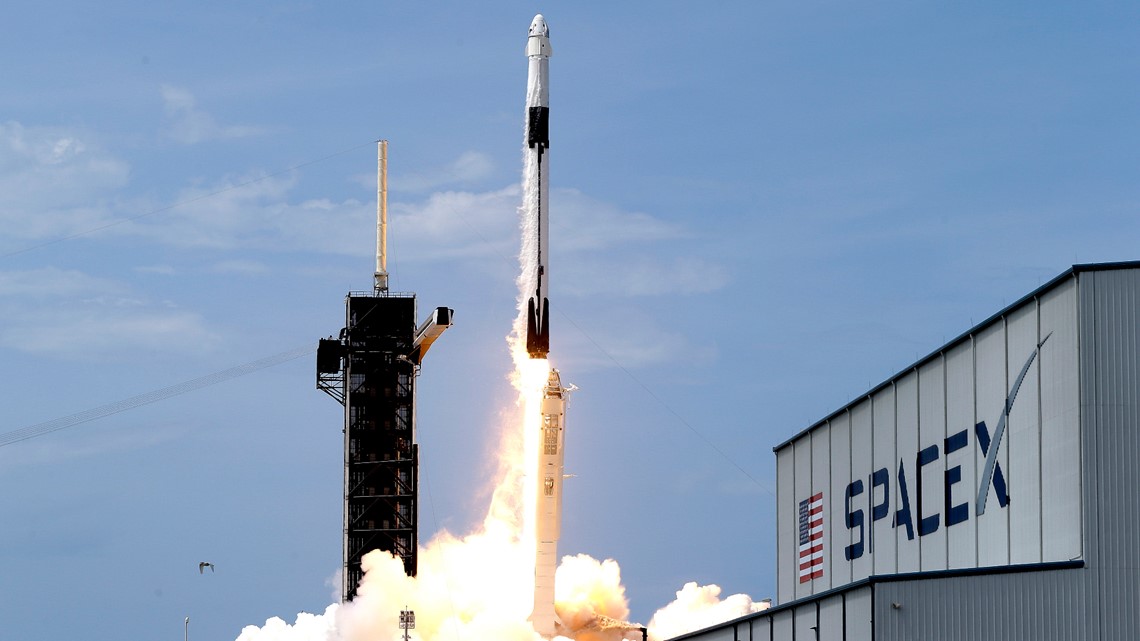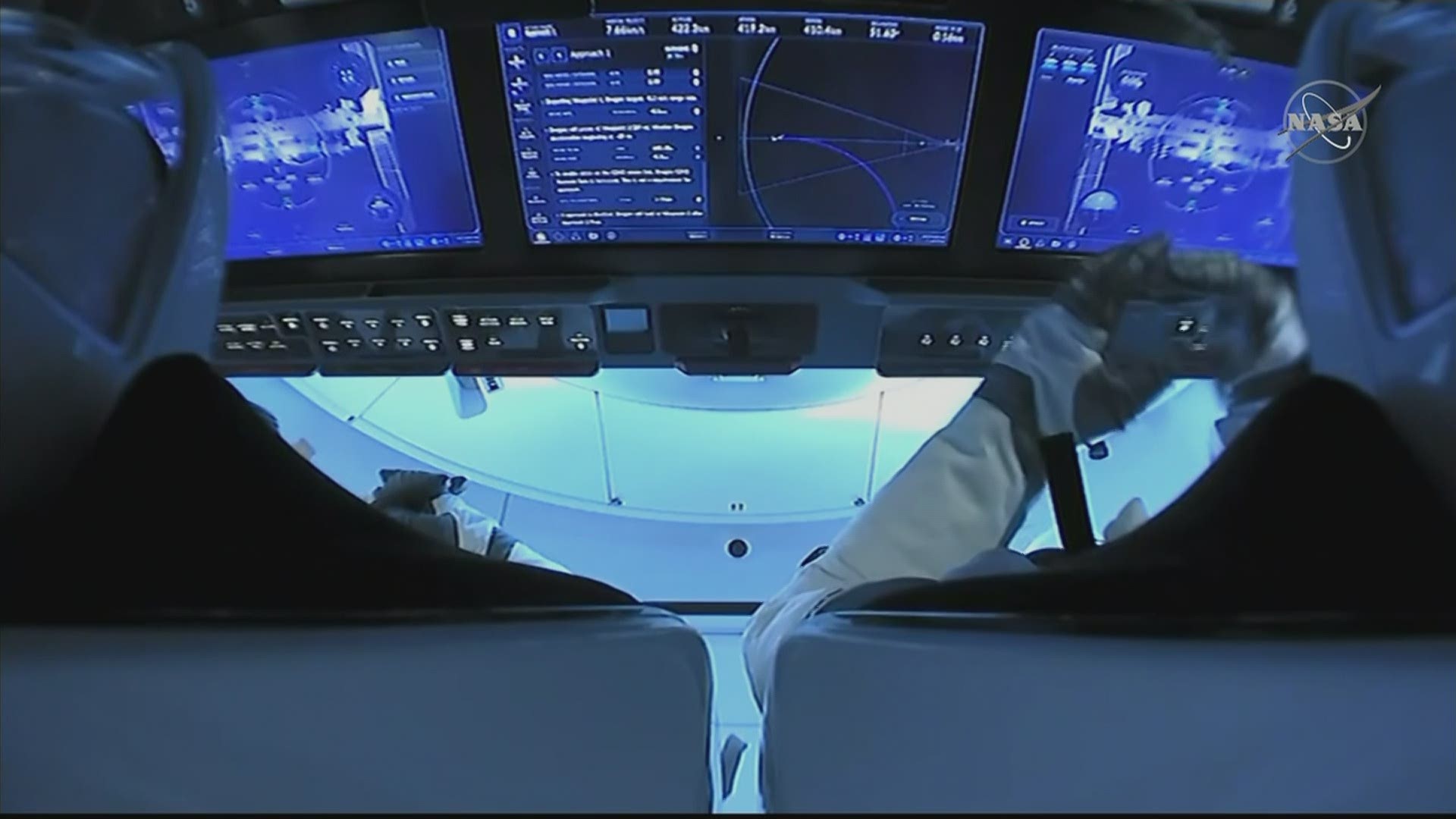WASHINGTON — Coming in ahead of schedule the Crew Dragon was able to dock after a little less than 19 hours of travel. Veteran astronauts Doug Hurley and Bob Behnken were inside SpaceX's Crew Dragon which has now docked onto the International Space Station's orbiting laboratory on Sunday. Hurley and Behnken were launched into space on the Crew Dragon Saturday making them the first NASA astronauts to head to the ISS from Florida since 2011.
The astronauts were awakened Sunday at 4:45 a.m. Eastern with "wake-up" music, another first that Space.com says hasn't happened since 2011. The ISS docking was scheduled for 10:29 a.m. Eastern.
Unlike the SpaceX and NASA flight control rooms, where everyone was spaced well apart, there was no social distancing or masks needed in orbit.
Despite the coronavirus pandemic, thousands jammed surrounding beaches, bridges and towns as SpaceX ended a nine-year launch drought for NASA. The achievement, years in the making, is expected to drive down launch costs so more people might be able to afford a ticket to space in the coming years.
“The whole world saw this mission, and we are so, so proud of everything you have done for our country and, in fact, to inspire the world,” NASA Administrator Jim Bridenstine said in a call from Mission Control in Houston.
Hurley credited SpaceX and added, ““It's great to get the United States back in the crewed launch business.”
Behnken told the welcoming committee at NASA's Johnson Space Center that the Dragon was “a slick vehicle” and said he was surprised at how rough the ride was on the latter part of ascent, compared with the space shuttle, which he and Hurley rode twice.
“Dragon was huffing and puffing all the way into orbit,” he said.
Two Texas members of Congress at Johnson for the docking — Sen. Ted Cruz and Rep. Brian Babin — said the flight offered inspiration and hope during a particularly tough time of protests and pandemic.
“Having it go off without a hitch was a tremendous blessing for our country,” Babin told the astronauts.
Gleaming white in the sunlight, the Dragon was easily visible on NASA TV from a few miles out, its nose cone open and exposing its docking hook as well as a blinking light. Hurley and Behnken took over the controls and did a little piloting less than a couple hundred yards (meters) out as part of the test flight, before putting it back into automatic for the final approach.
Once on board the space station, Hurley said the capsule handled extremely well. He was the pilot on the last U.S. spaceship to visit the space station — the last shuttle flight, by Atlantis, in July 2011.
Restoring American launch capability nine years later, he noted, “is just one effort that we can show for the ages in this dark time that we’ve had over the past several months to kind of inspire, especially the young people in the United States, to reach for these lofty goals.”
There was one small glitch: Hurley bumped his head entering the space station and frequently wiped his forehead during the welcoming ceremony.
NASA turned to private industry to pick up the slack following the shuttle fleet's retirement, hiring SpaceX and Boeing in 2014 for space station taxi services. Boeing's first astronaut flight isn't expected until next year.
Until Saturday, SpaceX had launched only space station supplies or satellites. The company's employees took to calling the astronauts “dads” to drive home the fact that two lives were at stake in this highly technical effort.
Clearly relieved, NASA Administrator Jim Bridenstine tweeted a big “welcome home” to the Dragon fliers — “America's two favorite dads.”
NASA has yet to decide how long Hurley and Behnken will spend at the space station, somewhere between one and four months. While they’re there, they'll join NASA's Chris Cassidy and two Russian station residents in performing experiments and possibly spacewalks to install fresh station batteries.
While U.S. astronauts will continue to catch a ride on Russian Soyuz rockets, it will be through a barter system now that NASA's commercial crew program has finally taken flight. NASA had been shelling out tens of millions of dollars for every Soyuz seat.
In a show-and-tell earlier Sunday, the astronauts gave a quick tour of the Dragon’s sparkling clean insides, quite spacious for a capsule.
The blue sequined dinosaur accompanying them — their young sons’ toy, named Tremor — was also in good shape, Behnken assured viewers. Tremor was going to join Earthy, a plush globe delivered to the space station on last year’s test flight of a crew-less crew Dragon. Behnken said both toys would return to Earth with them at mission’s end.
An old-style capsule splashdown is planned.
After liftoff, Musk told reporters that the capsule’s return will be more dangerous in some ways than its launch. Even so, getting the two astronauts safely to orbit and then the space station had everyone breathing huge sighs of relief.
As always, Musk was looking ahead.
“This is hopefully the first step on a journey toward a civilization on Mars,” he said Saturday evening.




